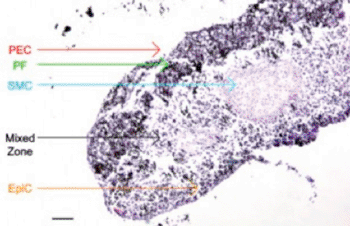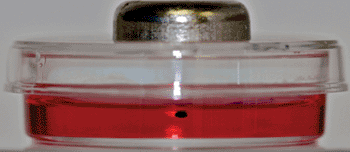Magnetic Nanoparticles Underlie New Technique for 3D Culture of Lung Tissue
By LabMedica International staff writers
Posted on 11 Feb 2013
A novel three-dimensional (3D) culture system was used to grow lung cells in vitro to yield a structured tissue that closely mimicked the actual condition inside the human lung.Posted on 11 Feb 2013
A longstanding goal in biomedical research has been to create methods for growing cell cultures in a fashion that faithfully represents native tissue environments. In particular, there is great interest in representative culture models of the lung, which is a particularly challenging tissue to recreate in vitro.
Investigators at Rice University (Houston, TX, USA) and at the biotech start-up company Nano3D Biosciences (Houston, TX, USA) developed a 3D growth chamber for lung tissue based on inert magnetic nanoparticles. Once the nanoparticles were ingested by cells, the cells could be manipulated with external magnets.
A report published in the January 10, 2013, online edition of the journal Tissue Engineering Part C: Methods described the use of "magnetic levitation" in conjunction with magnetic nanoparticles to create an organized 3D co-culture of the bronchiole that sequentially layered cells in a manner similar to native tissue architecture.
The 3D co-culture model was assembled from four human cell types in the bronchiole: endothelial cells, smooth muscle cells, fibroblasts, and epithelial cells. These cell layers were first cultured in 3D by magnetic levitation and then manipulated into contact with a custom-made magnetic pen, and again cultured for 48 hours. Hematoxylin and eosin staining of the resulting cell mass showed four distinct layers within the 3D co-culture. Immunohistochemistry confirmed the phenotype of each of the four cell types, and showed organized extracellular matrix formation, particularly with collagen type I.
Positive stains for CD31, von Willebrand factor, smooth muscle alpha-actin, vimentin, and fibronectin demonstrated the maintenance of phenotype for endothelial cells, smooth muscle cells, and fibroblasts. Positive stains for mucin-5AC, cytokeratin, and E-cadherin after seven days with and without 1% fetal bovine serum showed that epithelial cells maintained phenotype and function.
“One of the unique things about the magnetic levitation technology is that it allows us to move cells around and arrange them the way that we want for particular types of tissue,” said contributing author Dr. Tom Killian, professor of physics and astronomy at Rice University. “This is the first time anyone has arranged these four cell types in the same way that they are found in lung tissue.”
The magnetic levitation method of 3D culture of bronchiole tissue could solve a problem that is frequently encountered in testing the toxicity of airborne agents.
“With traditional two-dimensional cultures, it is very difficult to culture cells at the air-liquid interface, which is what you would prefer for toxicity testing,” said Dr. Glauco Souza, CSO of Nano3D Biosciences. “With our technology, we can easily levitate the bronchiole tissue to the air-liquid interface so that airborne toxins are exposed to the epithelial layer of the tissue, just as it would occur in the lungs.”
Related Links:
Rice University
Nano3D Biosciences
















